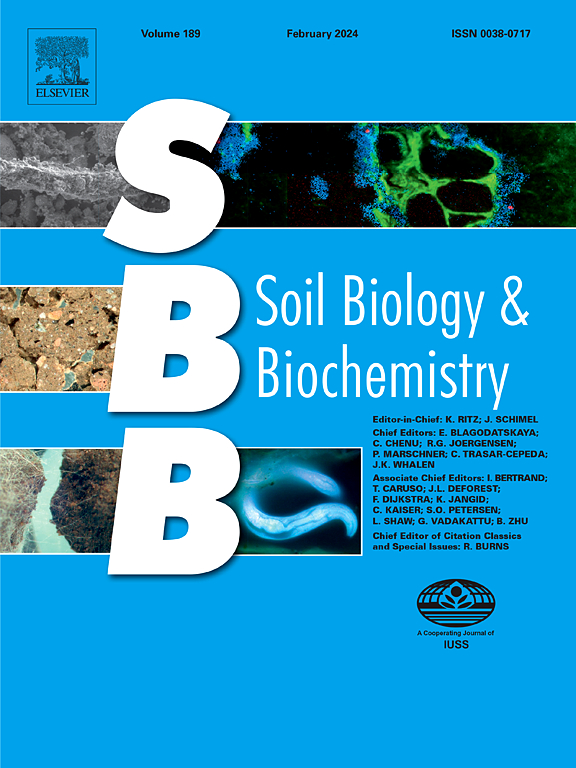Soil bacterial neutral lipid fatty acids: Markers for carbon storage or necromass?
IF 9.8
1区 农林科学
Q1 SOIL SCIENCE
引用次数: 0
Abstract
Intracellular carbon storage is a common strategy of soil microbes to cope with resource fluctuations. While fungal neutral lipid fatty acids (NLFAs) are widely accepted indicators of carbon storage, bacterial NLFAs are more ambiguous: they have been interpreted either as storage compounds or as degradation products of phospholipids, suggesting necromass. These conflicting interpretations limit the use of bacterial NLFAs in understanding microbial physiology and carbon cycling in soils. In this perspective, we revisit the functional origin of bacterial NLFAs by synthesising findings from microbial culture studies, screening of soil bacterial genomes, and a 13C-labelling soil experiment. Our results suggest that many soil bacteria possess the genetic and physiological capacity to synthesise storage lipids, and actively allocate excess carbon into NLFAs under carbon-rich conditions—supporting their interpretation as storage rather than necromass markers. We also highlight assumptions about phospholipid degradation and note that its products are not necessarily recovered as NLFAs. We conclude that soil bacterial NLFAs are mainly derived from storage compounds, although contributions from degraded phospholipids and possibly other intracellular lipids need further validation. We propose targeted experiments to clarify their biochemical origin, and highlight bacterial NLFAs as underused but promising markers in soil science.土壤细菌中性脂质脂肪酸:碳储存或坏死块的标记?
胞内碳储存是土壤微生物应对资源波动的常用策略。虽然真菌中性脂质脂肪酸(NLFAs)是被广泛接受的碳储存指标,但细菌中性脂质脂肪酸更不明确:它们被解释为储存化合物或磷脂的降解产物,表明坏死块。这些相互矛盾的解释限制了细菌NLFAs在理解土壤微生物生理学和碳循环中的应用。从这个角度来看,我们通过综合微生物培养研究、土壤细菌基因组筛选和13c标记土壤实验的发现,重新审视了细菌NLFAs的功能起源。我们的研究结果表明,许多土壤细菌具有合成储存脂质的遗传和生理能力,并在富碳条件下积极地将多余的碳分配到nlfa中,这支持了它们作为储存而不是坏死块标记的解释。我们还强调了关于磷脂降解的假设,并注意到其产物不一定作为NLFAs被回收。我们得出结论,土壤细菌NLFAs主要来源于储存化合物,尽管降解的磷脂和可能的其他细胞内脂质的贡献需要进一步验证。我们提出了有针对性的实验来澄清它们的生化起源,并强调细菌NLFAs是土壤科学中未充分利用但有前景的标记物。
本文章由计算机程序翻译,如有差异,请以英文原文为准。
求助全文
约1分钟内获得全文
求助全文
来源期刊

Soil Biology & Biochemistry
农林科学-土壤科学
CiteScore
16.90
自引率
9.30%
发文量
312
审稿时长
49 days
期刊介绍:
Soil Biology & Biochemistry publishes original research articles of international significance focusing on biological processes in soil and their applications to soil and environmental quality. Major topics include the ecology and biochemical processes of soil organisms, their effects on the environment, and interactions with plants. The journal also welcomes state-of-the-art reviews and discussions on contemporary research in soil biology and biochemistry.
 求助内容:
求助内容: 应助结果提醒方式:
应助结果提醒方式:


